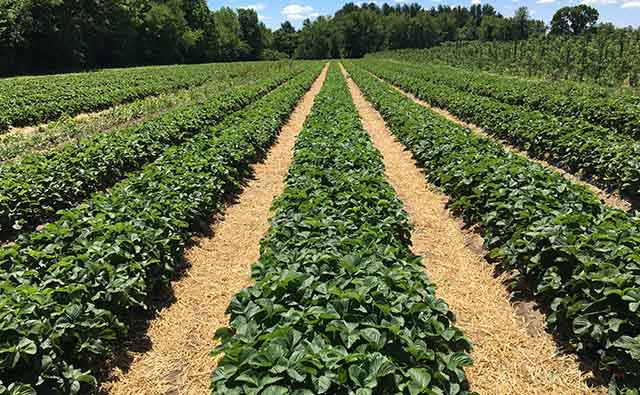Industry News, Fungicides, Feature Article, Company News, Agriculture & Feed, Adjuvants, Biopesticides
The Antitranspirant Adjuvants Also Effect The Plant Diseases Control

Industry News, Fungicides, Feature Article, Company News, Agriculture & Feed, Adjuvants, Biopesticides

According as the description by RHS Gardening, downy mildew is a disease of the foliage, caused by a fungus-like organism. It is spread by airborne spores and moisture as the infection is favored by prolonged leaf wetness. Especially during the rainy days in the late spring and early summer, the risk of infection is high because of the multiple rainfall and moderate to high temperatures. A terrible plant disease attack USA in January 2012, the plants in 33 states had been confirmed the heavily infected. Some papers result that the temperature suitable for production and spreading of spores was 15-20°C. After the invasion of the pathogen into the host, a large number of spores can be produced on the infected leaves when the incubation period is four to five days and the relative humidity is up to 83%.
Downy mildew can reduce the yield by 20-40%, the similar diseases have caused serious economic losses to the grown industry. But some of plant diseases has been resistant to conventional fungicides. The efficiency of disease control is also further reduced through loss of fungicide due to wind and rain at the same time.
In general, the rainfall and temperature are the key factors of plant diseases. We selected downy mildew to used as the reference disease sample, and collected the temperature/rainfall index from forty-eight main farming region around the world (Except of Asia region). Our report results that the T/R index of farming regions mainly locate in the high risk area of spores production. Especially in Europe, such as the crop farms on Nouvelle Aquitaine of France and the orchards on the eastern of UK.
Carbamate ester and Strobilurin are the most effective systemic fungicides treat on downy mildew, reduction of disease severity from 85% to 94%. Some plants, such as Pinus massoniana, Euonymus japonicus Thunb and Dalbergia hupeana Hance, the extracts also effect the same treatment. (Chen Jiao, 2003) Especially the inhibition rate of Pinus effects 88.46%, is the most effective plant extracts compared with other 57 spice samples.
Film forming adjuvant mainly used as the antitranspirants that sprayed on the foliage. The coating agent were compounded with water and applied at about 3% W/V. Fifteen years ago, a study (Waffa M. Haggag, 2002) results the 93.8% reduction on disease severity, is the second effective formula in the test.
In fact, the agricultural adjuvants have N on 1 properties for strengthen the fungicides. PINEYE® Emulsion is a nonionic type adjuvant. Forming a sticky coating on the surface of foliage. The natural contains are kind of biobased bacteriostasis active ingredients.
Silicon-based surfactants are the key products on adjuvant market. They are prepared by hydrogenated silicon and compounded with fungicides. Comparing to silicon-based adjuvants, PINEYE® Emulsion is extracted from plants, has excellent biological affinity.
| USAGE | APPLICATION |
| Antitranspirant | To protect crops, flowers and fruits defense the sunburn. Reducing the evaporation rate of foliage, improve the structure mode of water on the plant cell. |
| Sticker Forming | Forming a sticky elastic coating. Control the life of fungicides. Holds the effective ingredients on the plant surface when rains and water spreading on foliage. |
| Extender | Extend the effect time of fungicides. |
| Spreader | To helps the fungicides enter the hairy and waxy blade surface evenly. |
| Wetting Dispersant | Dispersing water and wetting foliage to reduce consumption of water. |
| Potentiating Agent | Compounding with fungicides and enhance the effects. |
| ACTIVE INGREDIENT | USAGE | TARGET PEST AND HOST |
| gamma-Terpinene | *Fungicide *Insecticide |
*Crop protection *Control of fleas and cockroaches *Powdery mildew on fruitsand vegetables and early blight on potatoes *Spodoptera littoralis, Aphis fabae, Hemiptera, Aphididae, Lepidoptera, Noctuidae |
| alpha-Terpinene | *Fungicide | *Crop protection *Control of various fungal pathogens *Powdery mildew on fruitsand vegetables and early blight on potatoes |
| alpha-Terpineol | *Fungicide | *Crop protection *Control of various fungal pathogens *Powdery mildew on fruitsand vegetables and early blight on potatoes |
| alpha-Pinene | *Fungicide *Insecticide |
*Crop protection *Control of various fungal pathogens *Powdery mildew on fruitsand vegetables and early blight on potatoes *Microplus |
| beta-Pinene | *Fungicide *Insecticide |
*Crop protection *Control of various fungal pathogens *Powdery mildew on fruitsand vegetables and early blight on potatoes *Microplus |
| Terpinolene | *Bactericide | *Bacillus subtilis, Staphylococcus aureus, Staphylococcus epidermidis and Escherichia coli |
| Para-cymene | *Fungicide | *Crop protection *Control of various fungal pathogens *Powdery mildew on fruitsand vegetables and early blight on potatoes |
| Terpinen-4-ol | *Fungicide *Microbiocide *Animal feed additive |
*Crop protection *Control of various fungal pathogens *Powdery mildew on fruitsand vegetables and early blight on potatoes |
| 1,8-Cineole | *Fungicide *Herbicides *Insecticide |
*Crop protection *Control of various fungal pathogens *Powdery mildew on fruitsand vegetables and early blight on potatoes *Herbicides *Microplus |
| Citronella oil | *Fungicide *Herbicide *Insecticide *Repellent |
*Various insects *Body lice, gnats, flies, wasps and dengue fever mosquito (Aedes aegypti) *Ragwort *Target host: Grass, rough areas, greencover |
| Eugenol | *Insecticide *Fungicide *Bactericide *Herbicide |
*Aphids, armyworms, beetles, cutworms, mites, weevils, various flies of the Order Diptera, Botrytis *Top fruits, citrus, grapes |
| Ocimene | *Insecticide, *Semiochemical *Pheromone *Fungicide |
*Leaf cutter ant *Carnation ring spot (CaRSV), carnation vein mottle viruses |
| Pine oil | *Fungicide | *Broad spectrum of activity against pest insects and plant pathogenic fungi |
| Pine tar | *Preservation *Repellent |
*Reptiles and insects |